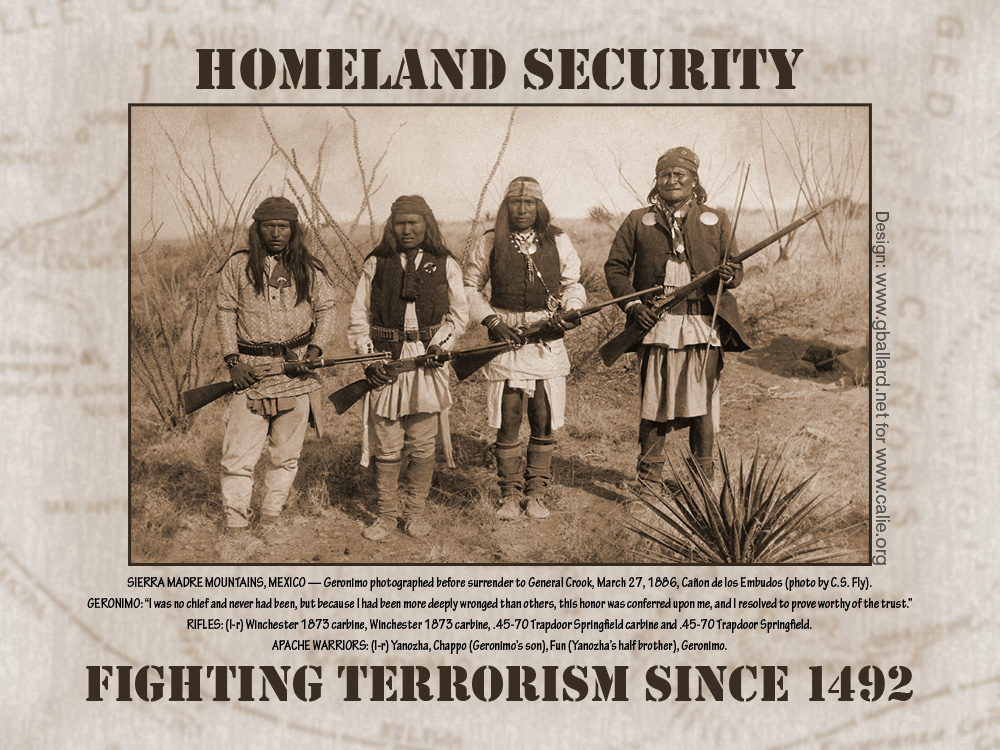FIGHTING TERRORISM SINCE 1492 Poster
Español | 中文 | 日本 | Française | Deutsch | 한국어 | Россию | پارس
FAMOUS HOMELAND SECURITY HEROS USA — Here's an original G. BALLARD design spin on these classic Indian fighter tribal homeland security headlines comparing the history of North American 21st century terrorism awareness in America with a famous Geronimo Native American Indian war photograph by C.S. Fly picturing Chief Geronimo with three Apache Indian warriors holding their period antique military rifles in the Sierra Madre Mountains of Mexico prior to surrendering to General Crook, March 27, 1886.
This is a fine-art poster project to top commercial standards by a professional photojournalist in Southern California.
|
GERONIMO RESEARCH
I am posting bits of my Geronimo research project I used to produce my classic "Homeland Security" Indian fighter poster BECAUSE it is important to know something about the indigenous American peoples and their tribal histories to better understand the meaning behind this POWERFUL ARTISTIC STATEMENT.
The Homeland Security Poster with indians becomes a lot more interesting to talk about when we know a few historical facts about Geronimo — how his small Apache Indian band arrived at this moment in American history, what the Mexican and United States governments had done to Geronimo's family and tribe, the 19th century ethnic cleansing taking place in America, and where Geronimo's tribe is today at the turn of the 21st century.
My Geronimo essay is about the famous American Indian warrior/chief, and includes Chiricahua and Mescalero Apache history briefs, historical records, vintage photographs with extended photo captions and background information about the famous Geronimo war photographic collection by C.S. Fly.
Please see my full GERONIMO RESEARCH GUIDE for more complete information about Chief Geronimo, including "Operation Geronimo" thoughts, a larger collection of professionally restored Geronimo warrior photographs with more extended historical photo captions.
|
|
CULTURAL DISCLAIMER — WAR HEROS or VILLAINS?
This famous 1886 American historical photograph of Geronimo and its headline connotation to "Homeland Security" and "Fighting Terrorism" has extreme deep-seated, inter-generational meaning to the native indigenous peoples of our great country, the United States of America, USA.
Many brave Indian warriors, many beautiful Indian women and grandmothers, and many innocent Indian children did not survive the post European contact military attacks by Spanish-Mexican-British-French-American government soldiers and civilian militias that overran and blatantly stole their ancestral homelands, decimated their populations and sought to erase their people from the Earth for their gold and legal ownership of their lands.
RESEARCH POST-CONTACT AMERICAN INDIAN HISTORY:
www.pbs.org GENOCIDE | ASSIMILATION | RELOCATION
|
|
GERONIMO POSTER IMAGE SCANNED FROM AN ORIGINAL 1886 PHOTOGRAPH — Label on Backside of Original Print:
The Geronimo photograph used in G. BALLARD's "Homeland Security" poster was scanned from an original C.S. Fly photographic print cabinet card (circa 1886). Below is a scan of the original 1800s copyright label attached to the backside of the original Geronimo cabinet card used to make the Homeland Security poster. Original "No. 174" Geronimo cabinet cards in this condition have sold for $10,000 USD on national auction websites — they are very rare and highly collectable in this remarkable condition.
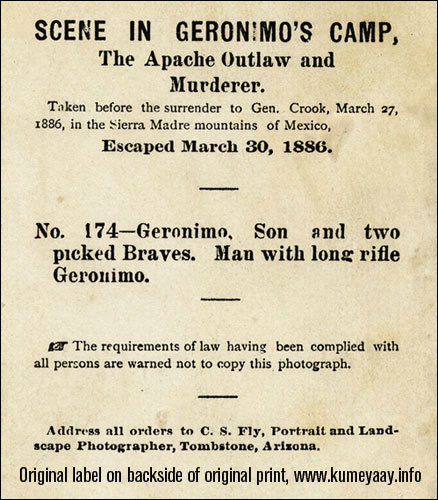 |
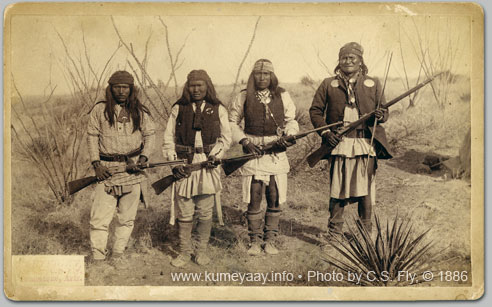 |
|
TRANSLATION:
SCENE IN GERONIMO'S CAMP, the Apache Outlaw and Murderer. Taken before the surrender to General Crook, March 27, 1886, in the Sierra Madre Mountains of Mexico, Escaped March 30, 1886. No. 174—Geronimo, son and two picked Braves. Man with long rifle Geronimo. |
As evident in the photographer's original 1886 studio caption, Geronimo aka Goyathlay and Goyahkla (Geronimo's original Indian name) was a very controversial Native American Indian warrior even among his own people....
- "(Geronimo's) 'renegades' or 'hostiles' as they were called, consisted of 35 men, eight boys, and 101 women and children (yet) they would occupy the attention of 5,000 troops, 500 Indian auxiliaries, and an unknown number of civilians...".
-James Hurst
MODERN 21st CENTURY PHOTO CAPTION:
Sierra Madre Mountains, Mexico, March 27, 1886 — Infamous Apache warrior Geronimo and three well-armed American Indian war heros posed for a photograph in their Indian camp holding late 19th century military rifles during a period of extended surrender negotiations with United States Army General George Crook.
APACHE WARRIORS PICTURED: (l-r) Yanozha, Chappo (Geronimo's son), Fun (Yanozha's half brother), and Geronimo at the Cañon de los Embudos (source: "The Apache Diaries, a Father-Son Journey" by Grenville Goodwin & Neil Goodwin).
The notorious Apache warriors, pictured here near the end of their resistance efforts at the Canyon de los Embudos (Canyon of the Funnels), about twenty miles south of the US-Mexican border, were to finally surrender to General Nelson A. Miles in Skeleton Canyon on September 4, 1886 (some six months after this historic photo was taken).
Geronimo's efforts in successfully resisting government forces are noted by historians as being the last significant guerrilla warfare actions by American Indians against the United States.
ARE THESE GERONIMO'S AUTHENTIC INDIAN RIFLES?
Many historians believe these are the Apaches' actual firearms (not prop guns given to them to make the scene more interesting). During my research, one such history buff noted he saw other historic period war photographs of Geronimo's warriors holding the same rifles.
HISTORIC INFORMATION ABOUT GERONIMO'S 1800s MILITARY CALVARY RIFLES:
INDIAN RIFLES PICTURED: (l-r) as Winchester 1873 carbine, Winchester 1873 carbine, .45-70 Trapdoor Springfield carbine and a .45-70 Trapdoor Springfield (source: "Guns of the Old West: An Illustrated Guide" by Charles Edward Chapel).
The thin rods Geronimo is holding are likely cleaning rods he pulled from his rifle that together would have been attached in a "X" to provide a "V" crotch for steadying the rifle for longer-range shots — so it appears Geronimo was the sharpshooter with the long rifle.
|
|
LEARN THE TRUTH FROM GERONIMO'S APACHE TRIBE 2011

WEBSITE www.chiricahua-apache.com
www.chiricahua-apache.com website is under development by the Chiricahua Apache Prisoner of War Committee, which consists of direct descendants of Chiricahua Apache prisoners of war. We all are enrolled members of the Mescalero Apache Tribe of New Mexico and our committee is authorized by the Mescalero Apache Tribe’s President, Vice President, and Tribal Council — WATCH THEIR VIDEO (this video is currently on view at the National Museum of the American Indian in Washington DC).
Another on-line Geronimo tribal study resource: HARLYN GERONIMO INTERVIEW 2006 (Geronimo's great grandson).
RECOMMENDED BOOK: "The Apache Diaries: A Father-Son Journey" by Grenville Goodwin and Neil Goodwin, University of Nebraska Press 2000.

Famous Geronimo quote:
“I was no chief and never had been, but because I had been more deeply wronged than others, this honor was conferred upon me, and I resolved to prove worthy of the trust.
"Late one afternoon when returning from town we were met by a few women and children who told us that Mexican troops from some other town had attacked our camp, killed all the warriors of the guard, captured all our ponies, secured our arms, destroyed our supplies, and killed many of our women and children...when all were counted, I found that my aged mother, my young wife, and my three small children were among the slain."
Excerpts from Geronimo's biography: Geronimo: His own Story
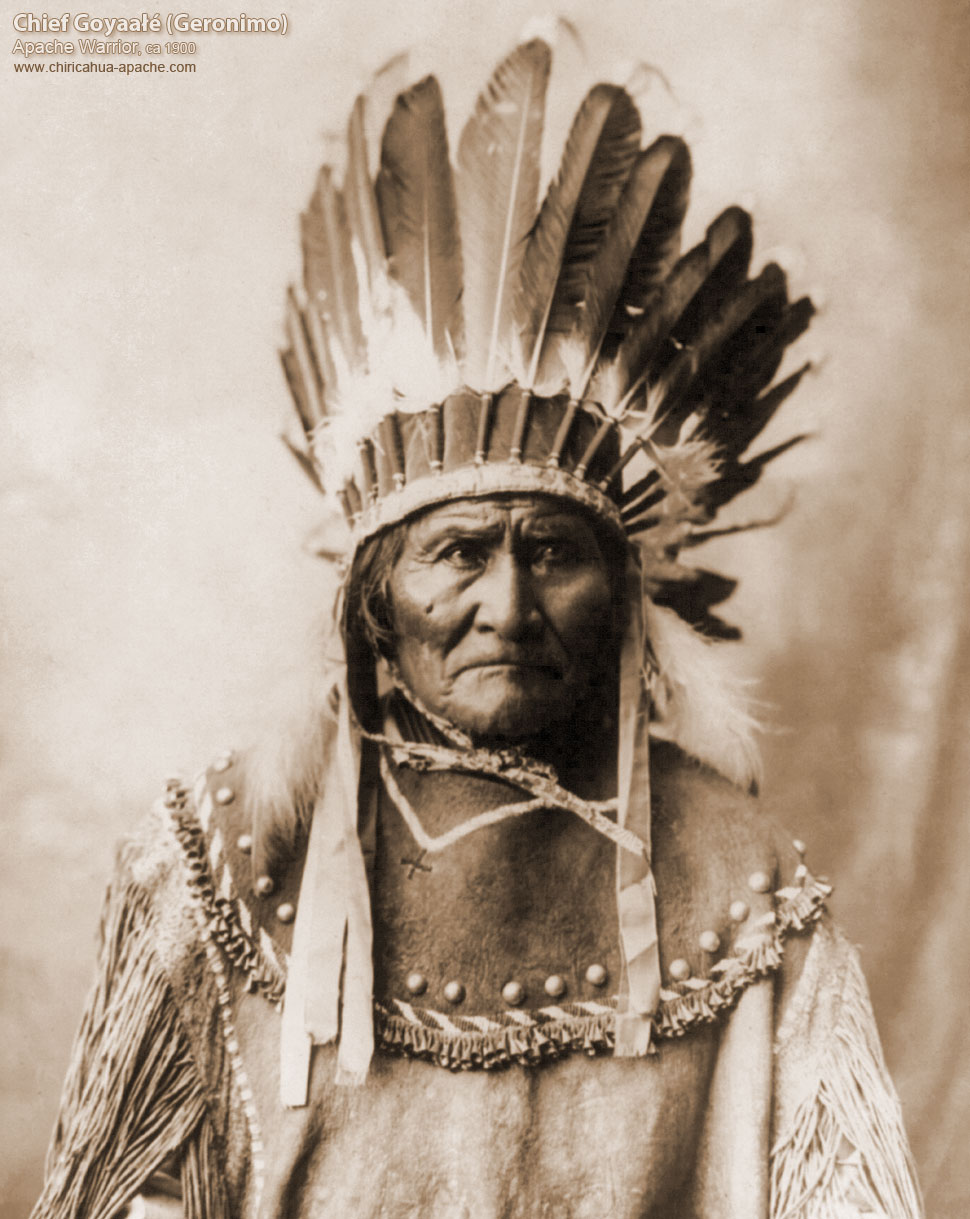
At around 70 years old, Chief Goyaałé (Geronimo) pictured circa 1900 in this high resolution ultra-famous portrait of a Native American chief wearing Indian eagle feathers in his headdress and adorned in fine traditional American regalia. Photo circa 1900, photographer unknown, digital restoration by G. BALLARD.
My on-line research indicates Geronimo was still imprisoned at Fort Sill, Oklahoma when he posed for this portrait.
After taking Geronimo into custody in 1886, the US government never permitted Geronimo to visit or see his beloved tribal homelands again — an area now owned by the United States government and known as the Gila National Forest in New Mexico — a designated Wilderness Area roughly 1.5 million acres of the most beautiful countryside on Earth.
Geronimo died in prison at Fort Sill, Oklahoma Feb. 17, 1909, and was buried there in the Fort Sill cemetery, but the Geronimo story doesn't stop there.
Did President Bush's grandfather and some of his buddies at Yale University dig up the grave of Chief Geronimo and steal his skull for their Skull and Bones society back in 1917? Harlyn Geronimo thinks so...so much so, in fact, he and family members have sued Skull and Bones (the secret society at Yale University linked to presidents and other powerful figures) and offered to provide DNA for comparison of the suspected Geronimo remains at the Skull and Bones so-called Tomb.
FAMOUS GERONIMO Quotes:
- Geronimo:
"No guns, no bullets could ever kill me. That was my power...Now my time is over."
Geronimo:
"I was born on the prairies where the wind blew free and there was nothing to break the light of the sun. I was born where there were no enclosures.”
1st Lieutenant Charles B. Gatewood:
"The Apache go where the best fight is. It's a moral value once you understand it."
Al Sieber, Chief of Scouts:
"There's two dead women there...and two little kids. They scalped them all, all four of 'em. Bounty hunters. The government down here pays 200 pesos a head for men, 100 for women and 50 for those kids. They kill any Indian and then claim they are Apache. I don't see how any man can sink so low. Must be Texans...the lowest form of white man there is."
2nd Lt. Britton Davis:
"As he handed over his weapons, Geronimo simply said: 'Once I moved about like the wind. Now I surrender and that is all.'"
|
HISTORICAL ACCOUNTS ABOUT GERONIMO:
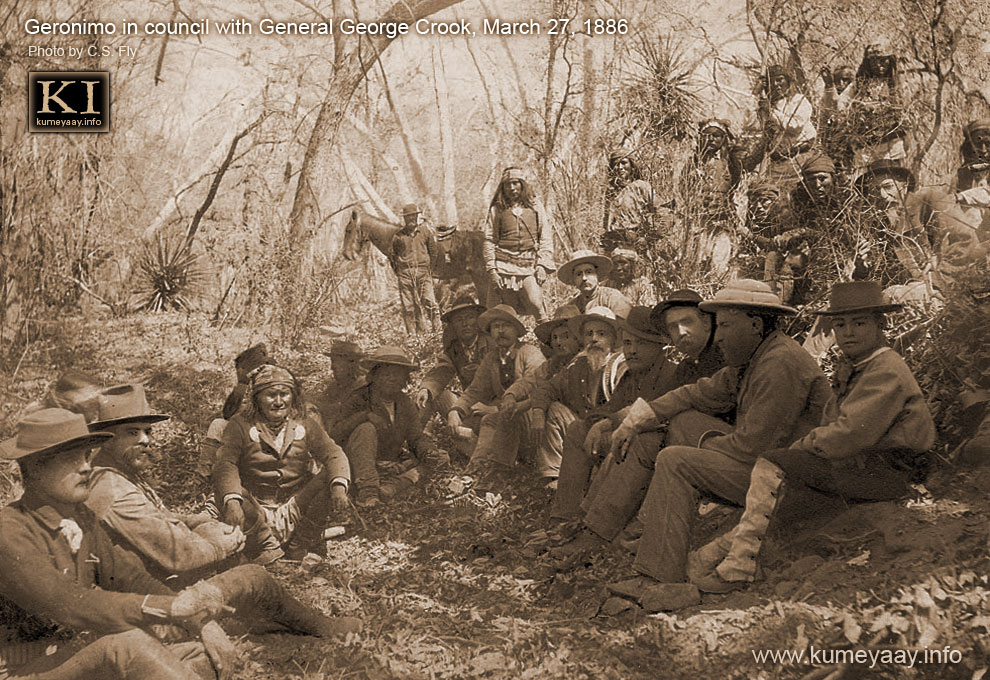
Photo caption: Geronimo pictured in council with General George Crook, March 27, 1886 (photo likely by C.S. Fly). Some of the US soldiers faces in this image appear to have been "worked on"...it's hard to guess when this was done, but most likely the retouching was done on an original print, copied into a new negative and reprinted at the turn of the 20th century long before Adobe Photoshop® was invented. Historical info: Neg. 4300-A, SPC 016048.06
JAMES HURST:
Here is an excerpt from a great Web article by James Hurst about some historical facts that eventually led to Geronimo's surrender in Skeleton Canyon around the time when the famous Geronimo picture was taken in 1886 (please see the link for the complete article):
- "On May 17, 1885, Mangus (son of Mangus Colorado), Chihuahua, Nachite, old Nana, the shaman Geronimo, and their followers fled the San Carlos reservation in Arizona in an attempt to regain the freedom they had known before the reservation system was instituted by the United States government.
"The "renegades" or "hostiles" as they were called, consisted of 35 men, eight boys, and 101 women and children. They would occupy the attention of 5,000 troops, 500 Indian auxiliaries, and an unknown number of civilians...".
-
BARBARA PING:
- SOURCE and great collection of Geronimo pictures:
Exhausted, and hopelessly out numbered, Geronimo surrendered on March 27, 1886 at Cañon de Los Embudos in Sonora, Mexico. His band consisted of a handful of warriors, women, and children. Also found was a young white boy named Jimmy "Santiago" McKinn, that the Indians had kidnapped some six months earlier in September. The "rescued" boy had become so assimilated to the Apache lifestyle, he cried when he was forced to return to his parents.
Also traveling with General Crook was the photographer, C.S. Fly of Tombstone fame. After the bands capture, he was able to take some of the most famous photographs in U.S. history.
The soldiers gathered the group and began the trek to Fort Bowie, Arizona. However, near the border, Geronimo, fearing that they would be murdered once they crossed into U.S. territory, bolted with Chief Naiche, 11 warriors, and a few women and boys, who were able to escape back into the Sierra Madra. As a result, Brigadier General Nelson A. Miles replaced Crook as commander on April 2, 1886.
At a conference on September 3, 1886, at Skeleton Canyon in Arizona, General Miles induced Geronimo to surrender once again, promising him that, after an indefinite exile in Florida, he and his followers would be permitted to return to Arizona.
The promise was never kept. Geronimo and his fellow prisoners were shipped by box-car to Florida for imprisonment and put to hard labor.
It was May 1887 before Geronimo saw his family. Several years later, in 1894, he was moved to Fort Sill in Oklahoma Territory where he attempted to “fit in.” He farmed and joined the Dutch Reformed Church, which expelled him because of his inability to resist gambling.
As years passed, stories of Geronimo's warrior ferocity made him into a legend that fascinated non-Indians and Indians alike. As a result, he appeared at numerous fairs, selling souvenirs and photographs of himself. In 1905 he was quite the sensation when he appeared in President Theodore Roosevelt's inaugural parade. Geronimo dictated his memoirs, published in 1906 as Geronimo's Story of His Life.
Never having seen his homeland of Arizona again, Geronimo died of pneumonia on February 17, 1909 and was buried in the Apache cemetery at Fort Sill, Oklahoma....
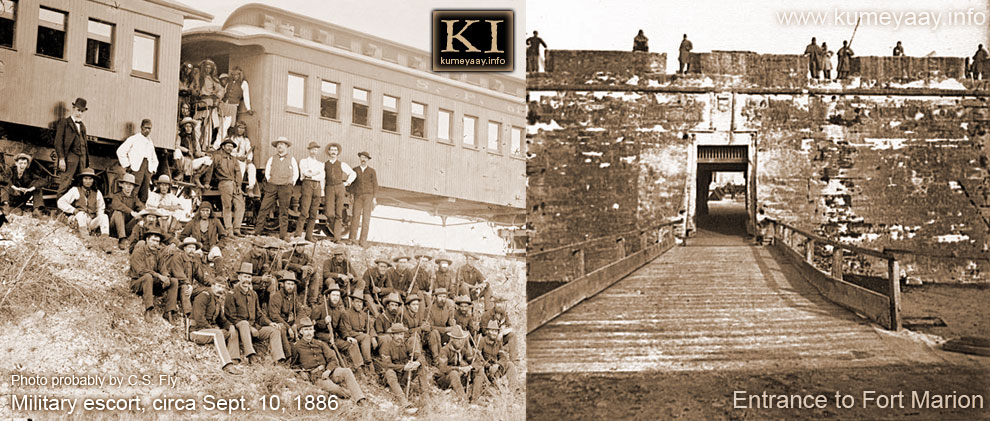
Geronimo's heavily-armed military escort guard posed for a photograph outside the prison train, circa September 10, 1886, pictures Geronimo Apache prisoners of war (POWs) near Nueces River, Texas. (Right) Entrance to Fort Marion, circa 1880s.
|
|

ABOUT THE GERONIMO PHOTOGRAPHER:
Camillus S. “Buck” Fly was a famous photojournalist of the late 1800s. He was born in California in 1850 and died in 1901. Buck Fly's photo studio was located in Tombstone, Arizona, and some researchers have said "The Gunfight at the OK Corral" is more accurately called the "Gunfight in the Alley by Fly's Photography Studio."

Historical Card: Dr. Patrick G Hardy Collection; Cochise County, Arizona
Professional digital scan of famous C.S. Fly original historical photograph printed on cabinet card, circa 1886. Geronimo on horse, label on backside reads:
- GERONIMO, THE APACHE CHIEF, As taken before the surrender to Gen. Crook in the Sierra Madre mountains of Mexico.
- Escaped March 30, 1886.
- The most fiendish, cruel and bloodthirsty of the Apaches now defying the United States and Mexico.
- The requirement of law having been complied with, all persons are warned not to copy this photograph.
Address all orders to C. S. Fly, Portrait and Landscape Photographer, Tombstone, Arizona. No. 188.
|
|
BUY FINE ART HOMELAND SECURITY POSTER FOR SALE:
G. BALLARD design studio can make commercial-grade fine-art poster prints of this Photoshop layout for sale. If you want information about how to buy a high-end archival poster print, please EMAIL G. BALLARD.
RECOMMENDED PRINT SIZES & PRICES:
14x18 at $75
20x24" at $125
24x32" at $175
44x52" (call)
plus shipping and handling and any applicable taxes.
CUSTOM LAYOUT: I can rework the layout to fit existing frame sizes.
FINEST MASTER PRINT QUALITY: Using the best high-end, museum-grade custom framing materials will only enhance the impressive professional quality of these digitalized master prints — I personally guarantee the aesthetic print quality will hold its own in any frame you put it in, and in any level of executive office, home, museum or tribal hall environment.
My Geronimo print is destined to be the true "Homeland Security" classic, a collector's artifact, a treasured family heirloom.
The below detail is how the "Actual Pixels" look on an 20x24-inch print — archival heat mounting is available on black Gator board, or museum-grade framing with UV non-glare glass.

I am a commercial imaging expert and this is the best scan I could get of an original photograph. I am very happy with it and it looks quite impressive even at the larger print sizes.
I am set up in-house to print on an 8-color "Epson 7880" archival printer and print on professional "Epson Premium Luster" photo paper — this combination is very tough (I've soaked prints in water overnight and dried them off the next day with no color or water damage).
HOW LONG WILL THESE PRINTS LAST:
Industry professionals speculate the color on these prints will last 100-plus years with normal care (framed behind UV glass and out of direct sunlight, away from excessive heat and humidity as you would display any other valuable artwork).
UNCONDITIONAL GUARANTEE:
I know what I am doing here and believe you will treasure your poster print as I do mine, so your purchase is guaranteed unconditionally and may be returned for any reason for one week after you receive it for a full refund as long as it is received here undamaged — check out the expert pixel and tonal quality:
|
|
